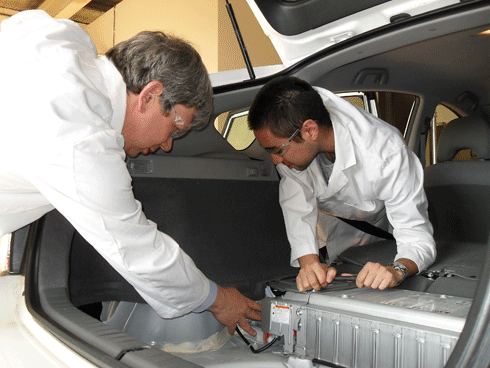
|
Published:
‘Electric driveway’ to plug hybrid cars into zero-emission house
Toyota Prius vehicles are being refitted by CSIRO engineers as part of an ‘electronic driveway’ initiative to transform family cars into low-emission mobile power units that could feed into low-emission homes.

|
|
Chris Phyland and Rob Dark work on converting a Toyota Prius into a plug-in hybrid electric vehicle. Credit: CSIRO
|
By replacing the small Prius battery pack with a larger one and adding a battery charger, the engineers are converting the cars from standard hybrid electric vehicles (HEVs) to plug-in hybrid electric vehicles (PHEV) that can be charged by plugging the battery into the grid or a renewable power source.
The main function of the small batteries in HEVs – which recharge during braking – is to achieve better fuel economy than a conventional fuel-only vehicle. Engineer Chris Phyland from CSIRO’s Low Emission Distributed Energy section says the PHEV adaptation will not only allow hybrids to be driven further on low-emission electrical power – up to 40 km – instead of fuel, but will also turn the parked car into a 6 kWh battery bank for a family home.
‘This power can be discharged to run appliances in the home, or it can be used for driving the vehicle,’ he adds.
‘PHEVs are not new technology but we are modifying them to support a completely unique application, that of using the car as a large mobile battery which can be integrated and used in our homes.’
The CSIRO electric driveway project links in with CSIRO’s earlier zero-emission house project – managed by Dr Greg Foliente – in which researchers have been working with Sustainability Victoria and property developers to design and build a carbon-neutral Australian home, currently under construction.
The new house is expected to use up to 70 per cent less energy than a traditional home of similar size.
The two groups are investigating possible synergies between a low-emissions car and house – for example, using the car battery to store energy from solar panels during the day that could be used to run appliances at night. A domestic mobile power source could also help minimise demand during peak load times on the grid.



